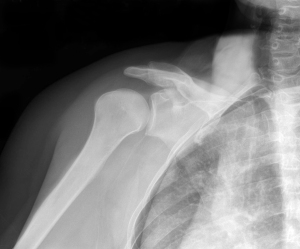In the first place, a logical consequence of rotator cuff tendinitis is that the inflamed tissue of the rotator cuff forms scarring, becomes brittle and eventually a rotator cuff tear occurs. This is usually a sudden event and occurs when the person wants to lift something heavy overhead.
However, there can be only a partial rotator cuff tear, which can heal on its own or can be repaired with shoulder arthroscopy as shown in this link.
Documentation of rotator cuff tear
At other times though it can be a chronic slow deterioration and only testing such as an arthrogram of the shoulder, which is a special X-ray following the injection of a dye and will show whether there is a torn rotator cuff. A shoulder MRI is also very useful to see how big the hole is. The orthopedic surgeon uses arthroscopy to repair a rotator cuff tear. The surgeon can often fix this by sewing it over with a few special sutures, where the one end has an anchor, the other end is a normal suture.
Reverse shoulder arthroplasty when arthritis is present
However, sometimes there is not enough healthy tissue to do this surgery. Even with successful surgery the overall result is often less than satisfactory as the scarring after the surgery leads to a relative shortening of the rotator cuff tendon and the range of motion in the shoulder suffers somewhat. However, strength is usually returning with surgical repair giving the patient the feeling that things are more like normal again (Ref. 2). The surgeon uses reverse shoulder arthroplasty when arthritis is present in the shoulder in addition to a rotator cuff tear. Surgeons in Europe have used this surgical procedure for over 20 years and the Food and Drug Administration approved it for the US in 2004.
Rotator Cuff Tear (Plain Shoulder X-Ray Will Not Show Tear)
References
1. ABC of rheumatology, second edition, edited by Michael L. Snaith , M.D., BMJ Books, 1999.
2. The Merck Manual, 7th edition, by M. H. Beers et al., Whitehouse Station, N.J., 1999.
3. Goldman: Cecil Textbook of Medicine, 21st ed.(©2000)W.B.Saunders
4. Ferri: Ferri’s Clinical Advisor: Instant Diagnosis and Treatment, 2004 ed., Copyright © 2004 Mosby, Inc.
5. Rakel: Conn’s Current Therapy 2004, 56th ed., Copyright © 2004 Elsevier
6. Wheeless’ Textbook of Orthopaedics: http://www.wheelessonline.com/ Several topics can be found under this link by entering the term you search for.
7. Suzanne Somers: “Breakthrough” Eight Steps to Wellness– Life-altering Secrets from Today’s Cutting-edge Doctors”, Crown Publishers, 2008







